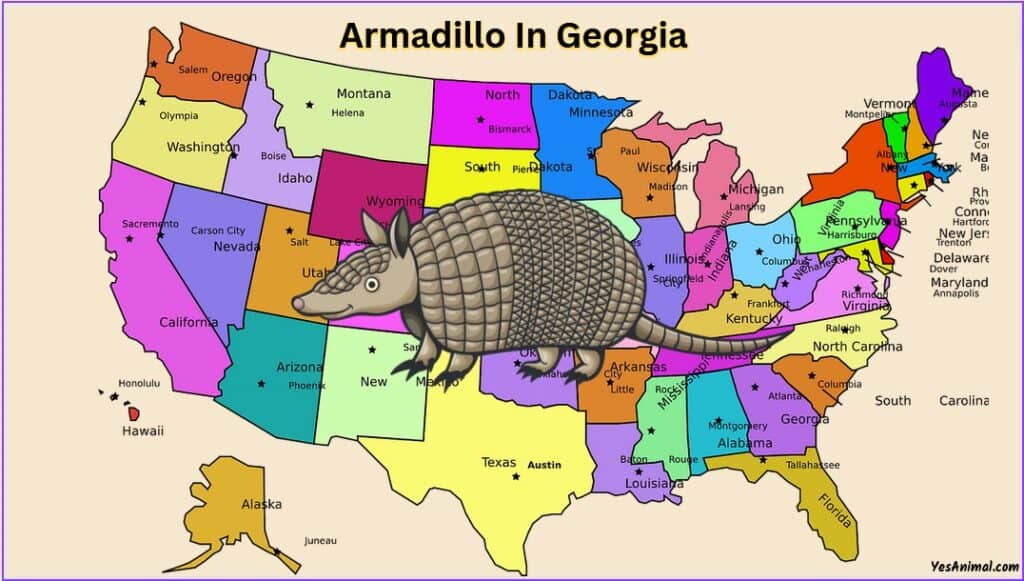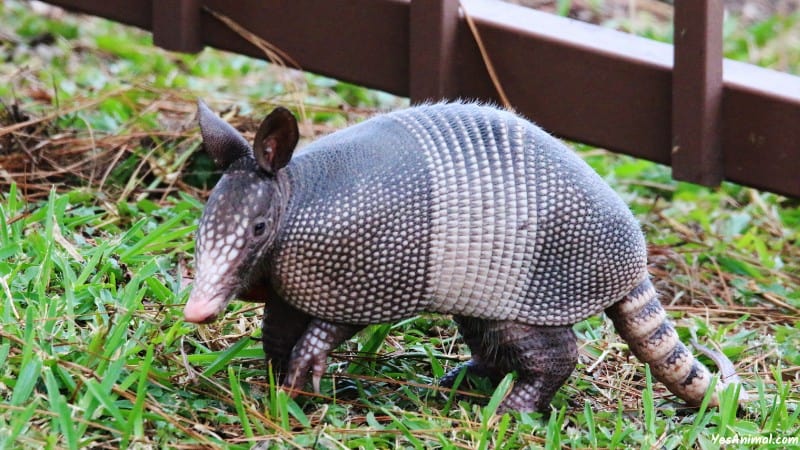Last Updated on April 15, 2024 by Amin Tawar

Georgia has a varied topography with mountains, rivers, coastal plains, forests, and marshes. So, it is no surprise that there are a variety of species that make the state their home. And one among them is the nine-banded armadillo.
Below In this article, I’ve explained everything you need to know about the armadillo in Georgia.
Do Armadillos Live In Georgia?
There is a leathery species, in Georgia that hasn’t always existed in the state, but which you might have seen digging holes in your garden or dead on the road. It is the nine-banded armadillo. Armadillos do thrive in Georgia. At the beginning of the 20th century, nine-banded armadillos were present in Texas.
By the end of the 1930s, they moved into Louisiana and had crossed the Mississippi River moving towards the east. During the 1950s, they moved to Florida and started heading north. Today, they are to be restricted within the state of South Georgia but, they live even till north Athens.
What Type Of Armadillo Is In Georgia?
Though there are more than 20 species of armadillo, only the nine-banded armadillo is a species that thrives in Georgia.
They are called nine-banded armadillos as they are known for the presence of lean, armor-like scales that are wrapping its body. The nine-banded armadillos have 9 to 11 plates on their armor. Unlike other armadillos, the nine-banded armadillos cannot roll up into a spherical ball.
Where Do Armadillos Live In Georgia?
Armadillos expanded their range into Georgia as it is an appropriate habitat that is fit for reproduction and consumption. They prefer habitats that are near streams and avoid excessively dry or wet extremes.
Soil is very important as they bury. Armadillos can be seen in hardwood woodlands, pine forests, grass prairies, coastal dunes, and salt marshes.
Human-created habitats like cemeteries, pastures, parks, croplands, and golf courses also provide them with a suitable habitat. They also forage roadsides.
Armadillos do not dig a burrow always; a few will even build nests. These nests correspond to smaller haystacks and are frequently used in wet soil areas. An individual’s home might vary from 4 acres in winter to 13 acres in summer.
How Did Armadillos Get In Georgia?

In the early ‘80s, armadillo populations moved inland from the coast of Georgia. The range persisted to increase in number, and the first one was seen in Clarke County in the year 2002.
Rivers can only act as a path for armadillos and not as a barrier for them to move toward the north. In Glynn, these mammals took about a year to successfully cross the Altamaha River to move into McIntosh County.
However, when they came to Athens, they traveled along the river corridors that are adjacent to the river. In 2010, however, the population of armadillos in Georgia stopped moving through the mountains and this was not simply because of problems with the height, but because of the chilly weather.
As they can’t tolerate temperatures that are below 36 degrees and do not really hibernate, so they have to remain occupied all year long.
Also Check Out Our Guide On Armadillo in US
How Big Are Armadillos In Georgia?
The armadillos in Georgia are about the height of a large house cat or an opossum. They are about 24 to 32 inches in length of which 9 to 14 inches are its tail. A larger male armadillo adult can weigh anywhere from 12 to 17 pounds whereas the larger female armadillo adult can weigh anywhere from 8 to 13 pounds.
They are usually brown to brownish yellow in color and have a few light hairs on their bellies. Their long claws enable them to be proficient diggers.
They have 4 toes on the front foot and 5 on the rear foot. The toes are extended so that a walking path looks more like a raccoon or an opossum. Their ears are around 1½ inches in length and they usually snout like a pig.
What Do Georgia Armadillos Eat?
Armadillos are generalist eaters. They utilize their sense of scent to hunt down nearly 500 distinct foods to find in the soil. Their diet usually consists of insects and various invertebrates of which most of them are cockroaches, beetles, wasps, fire ants, yellow jackets, scorpions, spiders, and white grubs.
A smaller part of the diet is composed of small amphibians and reptiles as well as eggs of birds and reptiles. A lesser than 10% of their diet is from seeds, fruit, fungi, and various other plant matter.
Their extremely sticky tongues enable these species to get colonies of insects or insect larvae from earthworms, spiders, scorpions, etc in a single given time. This will be done as they will find them when hiding under the dirt. They also eat Georgia snakes and the eggs of frogs, skinks, lizards, and snakes.
Can You Eat Armadillo In Georgia?
Though there is no law preventing you from eating an armadillo in Georgia, you must not consume one. This is because there is an alleged connection between armadillos and leprosy in the southern states of the United States.
Many suspect armadillos have been the primary reason for people getting leprosy despite not traveling and being at home. So, it is suggested not to consume armadillo meat even if you are curious about its taste.
Can You Shoot An Armadillo In Georgia?
If you are looking to get rid of armadillos from near your home, then you must eliminate the food source or you can try trapping them. Armadillos in Georgia are not protected by the law, so they can be hunted, eaten, and also captured at any time of the year.
Also, since there are no specific dangers to their survival and have very few natural predators they can be trapped or hunted.
Many armadillos are usually killed when they try crossing roads or when feeding near roadsides. Though acquiring leprosy from an armadillo is occasional, wearing gloves before handling one is the safest.
Also Check Our Guide On Armadillos In Florida
Can You Own An Armadillo In Georgia?
Armadillos are regarded as both a pest and an exotic species. Thus in Georgia, the law forbids keeping armadillos in confinement.
Though they do provide a fantastic service by consuming unwanted insects, armadillos can tear up your lawn. And remember these are wild animals, and can also be having some harmful diseases. So, it is advised not to own an armadillo as a pet.
Conclusion
And that was everything you need to know about the Armadillo In Georgia. I hope this article answered all your queries.
Thank You For Reading!
Our Goto Source For This Guide